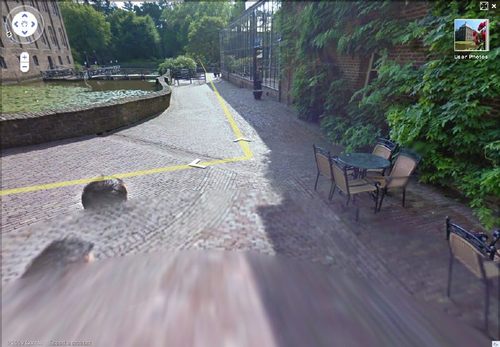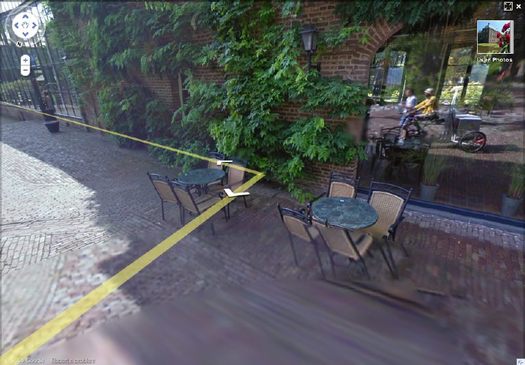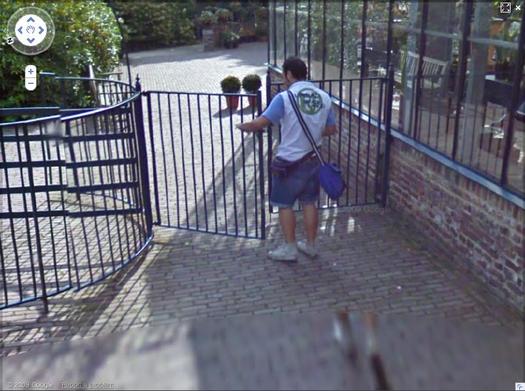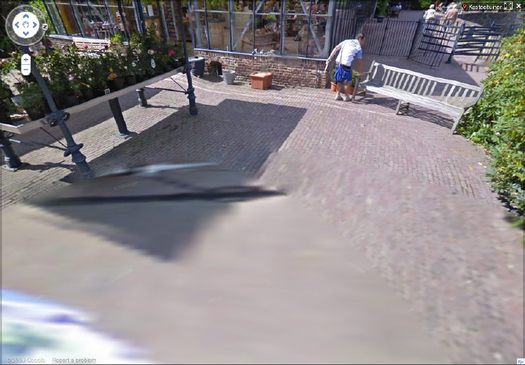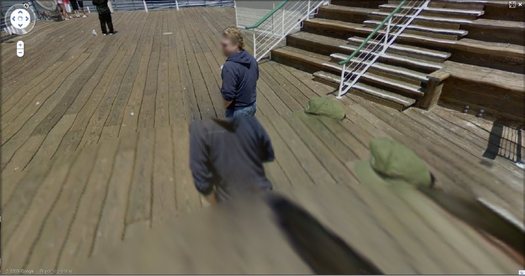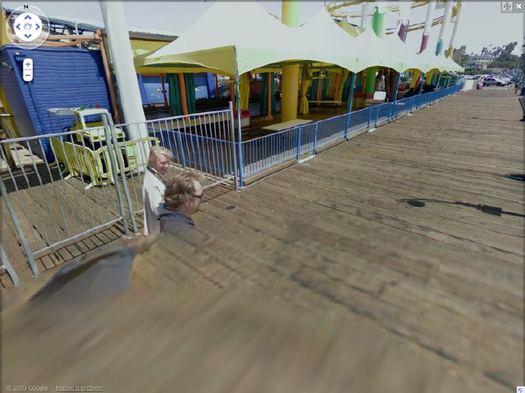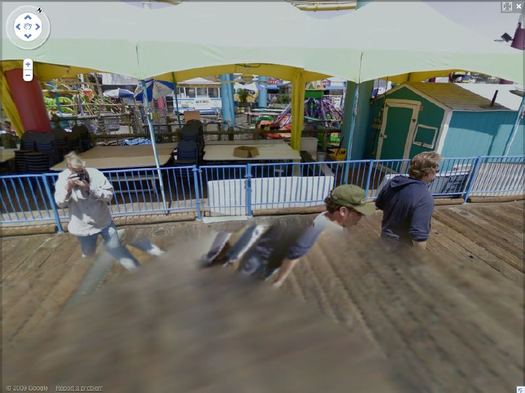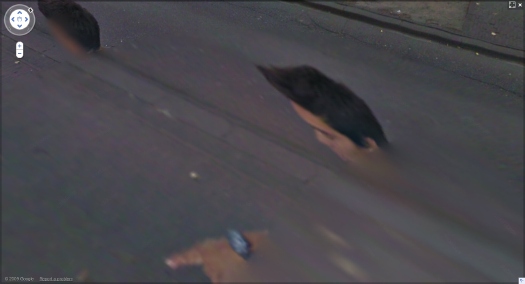
Some interesting developments since putting the Walking Man self-portrait collection out there. Thanks for the feedback and responses.
I think it's becoming clearer that walking man is not, as I wrote, a guy who "came upon the Google Street View Trike preparing to map the Binnenhof" and who "decided to tag along." Instead, he's probably part of the Google Trike crew.
I'd always entertained the possibility, and when, after the initial burst of discovery and image extraction, I found some additional panos from around the lake that made it clear his relationship to the Trike was at least a factor in his appearances.
From the intro I wrote for the proof [which I'll probably publish at some point, even as I plan to revise it for any future editions]:
His actions in the final two panoramas lend themselves to speculation: In his penultimate appearance, walking man becomes pointing man; he is seen gesturing across the plane, breaking the fourth wall, as it were, by addressing the Google Trike driver himself.Yes, yes it is.Perhaps this crossed a line about the presumption of passivity for Google's photographic bystanders. Or maybe it violated some rule of non-engagement, a Street View Prime Directive. Is it possible that he'd been talking with the Trike rider, his personal [sic] camera operator, all along?
When I showed the book to a Dutch neighbor Alexander the other night, I had already begun searching for other Google Trike maps [and pictures of the Trike in action]. After some quick assessments ["Dutch men don't wear flip-flops."] Alexander dug up some Dutch-language news reports of other Trike sites, such as the Kasteeltuinen Arcen, a 17th-century castle garden complex in northern Holland. Which is, right out of the gate, probably one of the most Dadaist landscapes imaginable for Google Street View. Just check out this absurd map:
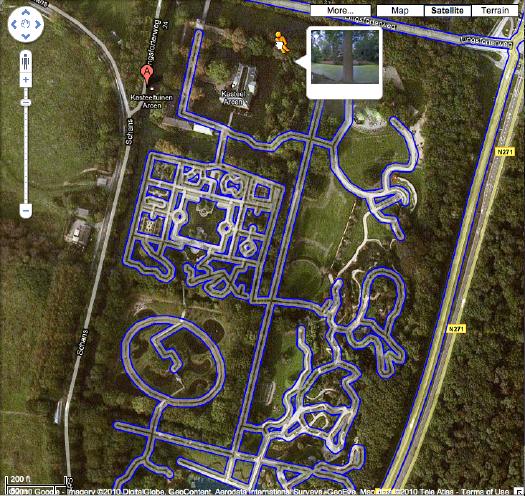
Sure enough, there's a familiar, disembodied hairdo. The Google Trike self-portrait is now officially a series, or a genre, even:
And just a few degrees over in this same pano, Alexander spots this magnificent reflection:
Our Google Street View Trike Team. [Neither of whom seems to be the Binnenhof's walking man, btw.]:
Alexander coined the term, "Google guide" to describe him, which is nice. And this one does appear to be holding a map of the castle grounds. But I'd probably call him a "Google grip." He opens and closes gates for the Trike:
And then he repositions garden furniture for no apparent reason, [while appearing in classic, spatio-temporal distortion portrait style at the bottom of the pano]:
Meanwhile, I was looking back at the first, proof-of-concept Google Trike maps, many of which, Google's press release tells us, were done by the inventor of the Trike itself, Street View Senior Mechanical Engineer Dan Ratner. Such as the Santa Monica Pier.
Where the Trike seems to have had not one, but two members in its entourage:
When I first pulled this map up on Tuesday night, there was a pano that had both grips walking ahead of the Trike at 10 and 2 o'clock, almost like bodyguards. What stood out immediately, was that both men's faces were not blurred. Google employees' prerogative, I guess. When I went back to screencap it, though, the entire pano was gone.
The Google folks are clearly aware of how the Trike changes the Street View dynamic: not just by adding a human face to the automatic surveying mix, or moving the camera/scanner from anonymous/invisible car to approachable, fun-looking pedicab. The Trike reveals a lot about how Street View is made, and also about who is making it.
Google is now in pedestrian space; they've become the world's most prolific street photographer, taking on the history, conflicts, context, and social baggage of anyone who's ever set up a camera in public. And that includes some legacy assumptions about the photographer's position: his gaze, his presence, and his process.
Here's another excerpt from the current draft of the walking man intro:
The typical Google Street View image seems to exist in a perpetually instant present. There are no time stamps to indicate when the photos were taken, and the user's simulated movement through panoramas conveys no sense of the passage of time; nothing else moves, and there is no beginning or end. By constantly inserting himself into the Binnenhof photos, the walking man provides a rare point of reference, an identifiable marker for tracking the Google Trike's operation. Most radically, he provides Street View with a subject--himself--and a narrative--his journey. His inadvertent co-star is the Trike--and by extension, Google's gaze itself.
An interesting encounter on the back side of the roller coaster shows how Google's Street View team became aware of this subject/narrative shift, and its implications for them personally.
A man with a camera had passed them, then doubles back, and engages the grip:
And then he takes a picture. Ironically/instinctively, the grip moves out of his shot:
The distorted portraits in the next pano show that, in fact, both grips are there:
The middle pano, of the man photographing the Trike, also appears to have been removed in the last day or so. Fortunately, I had left it open in another browser window already.
As I was posting this, my friend John sent along a pair of great quotes from Stewart Brand and Robert Smithson on the subject of infrastructure as subject:
Stewart Brand:In an interview Dan Ratner gave last fall during the happy campaign to vote for Google Trike sites, he said, "If you want me to get a little bit philosophical, I think that humans have really evolved to be visual animals. There's just something in our brain--an image lights up a lot more hotspots in your cortex than simple text or a map view would."
One wry definition of infrastructure is: "something grey, behind a chain-link fence." The message is: "Don't look, don't touch, don't even think about what this grey thing is for." We're trained to overlook infrastructure.
[Whole Earth Discipline, p. 16]Robert Smithson:
For instance, the Peligre Dam in the Republic of Haiti consists of 250-foot high concrete buttresses. This massive structure , with its artificial cascades and symmetrical layout, stands like an immobile facade. It conveys an immense scale and power. By investigating the physical forms of such projects one may gain unexpected aesthetic information. I am not concerned here with the original 'functions' of such massive objects, but rather with what they suggest or evoke....
Usage precedes meaning.
["Towards The Development of an Air Terminal Site," Robert Smithson: The Collected Writings, p. 58]
In walking man I described "Google's extraordinary, ongoing portrait of the entire world," but I think that's barely the beginning. In his speech a couple of weeks ago on the meaning of maps, Google's Michael repeatedly spoke of Google Earth/Maps/Street View as a browser, not content. Jones scoffed repeatedly at Google's being compelled to blur out human faces when there are "500 billion images" online with no blurring at all. He showed examples of Street View and Maps populated by user images, beginning with Panoramio, which Google acquired a couple of years ago.
These maps, these apps, are not information; they're infrastructure which we, the users of the world, will be expected to populate with our information, and then to inhabit.
Which makes these fleeting, fragmented glimpses at how this massive visual structure is being built--and by whom--all the more interesting to me. I guess I'm a sucker for unexpected aesthetic information.

